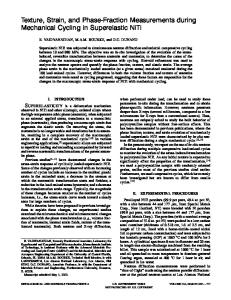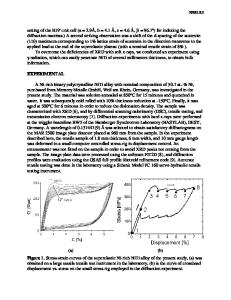Constitutive Equation of NiTi Superelastic Wire
- PDF / 410,514 Bytes
- 6 Pages / 414.72 x 648 pts Page_size
- 83 Downloads / 283 Views
Mat. Res. Soc. Symp. Proc. Vol. 459 c 1997 Materials Research Society
Wu et al. [8] studied the strain-rate effect of the NiTi superelastic wires. In their study, two conditions are carefully maintained to avoid the self-heating (or self-cooling) effect. First, the finest NiTi wire available in the commercial market (d-0.0254 mm) was used to conduct the tests. Secondly, all the tests were conducted in water. The experimental results clearly show that the strain rate has no effect on the superelastic behavior of the tested shape-memory wires when these two conditions are fulfilled. Their results agree with the Rodriguez's viewpoint, i.e., the apparent strain-rate effect, commonly observed in the large diameter wire tested in air, is caused by the self-heating or self-cooling effect rather than by the strain rate itself. This paper presents the results of a continuous effort on the mechanical behavior of A constitutive equation has been proposed to describe the superelastic wire in our group. An attempt has been made to apparent stress- strain-strain rate-temperature relationship. conduct experiments to verify the model and to provide a database for the design of the superelastic devices and applications using superelastic wires. CONSTITUTIVE STRESS-STRAIN-STRAIN RATE-TEMPERATURE EQUATION As stated above, the commonly observed strong influence of the strain and strain rate on the threshold stress for the stress-induced austenite-to-martensite transformation is an apparent phenomenon. The nature of this phenomenon is associated with the latent heat of the material and the thus-induced self-heating effect. Here, it was assumed that the stress of the superelastic wire during the stress-induced austenite-to-martensite transformation is independent of the strain and strain rate, but dependent on the real-time temperature of the wire. The stress-strain-strain ratetemperature constitutive equation of the shape-memory alloy during the stress-induced austeniteto-martensite transformation could be easily described by the Clausius-Clapeyron relationship as follows: (1) S=To+ap T, where T, is the real-time temperature of the superelastic wire. cr is the threshold stress for the stress-induced austenite-to-martensite transformation at the real temperature of the wire, T,. ap is a coefficient in the Clausius-Clapeyron relationship. If the test is conducted in an environment with a temperature of T, the real-time temperature of the wire, including the effect of selfheating, can be described by the following equation: (2) T,= T+AT(FE) for the stress-induced austenite-to-martensite (2), the threshold stress Combining Eqs. (1) and transformation at the environment, T, strain, F, and strain rate, i, can be expressed as follows: (3) ( i)1 = ao + ap T+ ap A T( e, i) a = ao +A Ts = ao +A[ T+ AT e, Equation (3) describes the stress-strain-strain rate-temperature relationship of the superelastic wire. Here, the key is to determine the AT( F, i) as a function of strain, e,and strain rate, L. Assume at a certain time, t, the temperature of
Data Loading...











